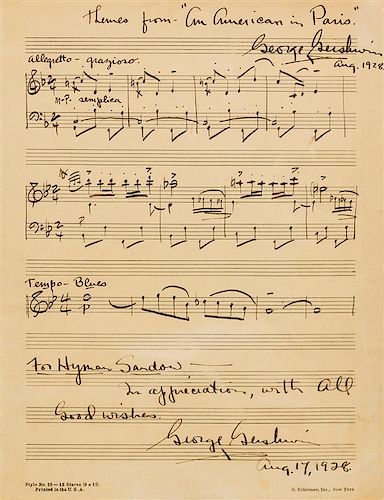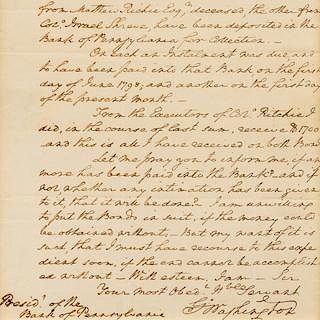* GERSHWIN, George (1898-1937). Autographed musical manuscript signed twice ("George Gershwin"), to Hyman Sandow, 17 August 1
Lot 260
About Seller
Hindman
1338 West Lake Street
Chicago, IL 60607
United States
Recognized as the Midwest's leading fine art auctioneers, Hindman Auctioneers has built a worldwide reputation based on a full service approach to the auction business tailored to meet the individual needs of our clients. Coming from a variety of educational backgrounds, specialists bring years of e...Read more
Categories
Estimate:
$6,000 - $8,000
Absentee vs Live bid
Two ways to bid:
- Leave a max absentee bid and the platform will bid on your behalf up to your maximum bid during the live auction.
- Bid live during the auction and your bids will be submitted real-time to the auctioneer.
Bid Increments
| Price | Bid Increment |
|---|---|
| $0 | $25 |
| $500 | $50 |
| $1,000 | $100 |
| $2,000 | $250 |
| $5,000 | $500 |
| $10,000 | $1,000 |
| $20,000 | $2,500 |
| $50,000 | $5,000 |
| $100,000 | $10,000 |
About Auction
By Hindman
May 1, 2018
Set Reminder
2018-05-01 11:00:00
2018-05-01 11:00:00
America/New_York
Bidsquare
Bidsquare : Fine Books and Manuscripts
https://www.bidsquare.com/auctions/hindman-auctions/fine-books-and-manuscripts-3113
Hindman Bidsquare@hindmanauctions.com
Hindman Bidsquare@hindmanauctions.com
- Lot Description
* GERSHWIN, George (1898-1937). Autograph musical manuscript, titled "Themes from 'An American in Paris.'" Signed twice ("George Gershwin" below title and dated "Aug 1928," and again below inscription at bottom dated "Aug. 17, 1928"), inscribed to Hyman Sandow. N.p., 17 August 1928.
1 page, 4to, on a single sheet of 12-stave printed music paper, slightly toned; matted and framed. Comprising twelve measures of three themes from his tone poem, An American in Paris, in three lines (the first two line over two staves each), the opening theme in four measures, another theme in the next four measures, and the blues theme in the remaining four measures. With the tempo marking: "Allegretto-grazioso" and "Tempo-Blues," and the dynamics "m-p-semplica" and "p."
Gershwin composed An American in Paris in 1928, inspired by the times he had spent in Paris. Evoking the sights and energy of the French capital in the 1920s, it became one of his best-known compositions. Gershwin composed An American in Paris on commission from the conductor Walter Damrosch. He scored the piece for the standard instruments of the symphony orchestra plus celesta, saxophones, and automobile horns. He brought back some Parisian taxi horns for the New York premiere of the composition, which took place on December 13, 1928, in Carnegie Hall, with Damrosch conducting the New York Philharmonic. Gershwin completed the orchestration on November 18, less than four weeks before the work's premiere.
Inscribed on the lower three unused staves to Gershwin's friend and early supporter, the music journalist Hyman Sandow: "For Hyman Sandow- In appreciation, with All Good wishes. George Gershwin / Aug. 17, 1928." An article by Sandow entitled "Gershwin to Write New Rhapsody," had appeared in Musical America on February 18, 1928 discussing Gershwin's forthcoming work, and his support of the piece was undoubtedly much appreciated by Gershwin as evident in this inscription. The article is frequently cited for the composer'ss early description of a "blues" episode that forms the central section of the work. This article is reprinted in Suriano, Gershwin in His Time, p. 58. See Musical America, Vol. 47, no. 18, February 18, 1928.
Estimate $ 6,000-8,000
Property from the Robert L. McKay Collection, North Tustin, California
- Shipping Info
-
For more information regarding shipping please visit Leslie Hindman Auctioneers' Shipping and Packing page.
-
- Buyer's Premium



 EUR
EUR CAD
CAD AUD
AUD GBP
GBP MXN
MXN HKD
HKD CNY
CNY MYR
MYR SEK
SEK SGD
SGD CHF
CHF THB
THB











